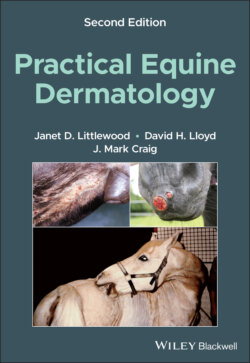Читать книгу Practical Equine Dermatology - David H. Lloyd - Страница 25
Biopsy samples
ОглавлениеSkin biopsies may be collected for a variety of reasons, including histopathology, fungal or bacterial culture, viral identification with electron microscopy, and immunohistochemistry. If in doubt, consult a pathologist as to the best way to process and transport the biopsy to the laboratory.
Figure 1.6 Fine needle aspiration of a nodular lesion.
Source: Courtesy of Liz Steeves.
There are three common ways to take biopsy samples: by excision, biopsy punch (Figure 1.7), or shave biopsy (see Chapter 3). The most common is the punch biopsy technique described below.
Sedation is generally necessary, followed by local analgesia. For the distal limbs, a nerve block (low or high four‐point or abaxial sesamoid, depending on the area involved) may be performed or local infiltration below the sample site or as a ring block around the lesion. For facial and difficult to access sites, such as inguinal and perineal lesions, general anaesthesia may be required.
Areas that include primary lesions should be selected where possible and sites not marred by medication. Take multiple samples unless only one lesion type and stage is present.
Because sample orientation during histopathological processing cannot be predicted, ensure that the whole punch sample includes tissue of interest. If normal skin is to be included for comparison, this should be taken as a separate sample in an appropriately labelled pot. Where you wish to investigate the transition between lesional and healthy skin, take an elliptical excision sample with the long axis going from normal to abnormal.
The selected sites may be marked using a coloured marker. Try to avoid areas overlying superficial ligaments, blood vessels, nerves, or superficial synovial structures associated with tendons and joints.Figure 1.7 The punch biopsy procedure enables rapid sampling and is suitable for most equine lesions.Source: Courtesy of Harriet Brooks.
It is important not to prepare the site surgically before sampling, since this removes surface material which may be of great diagnostic value.
The selected site may be anaesthetised by injecting approximately 1–2 ml of mepivacaine or lignocaine hydrochloride without adrenaline into the subcutaneous tissue below the lesions.
Wait for 2–3 min and test for sensation at the site with a needle.
Use a 6–9 mm biopsy punch; generally, the larger the size of the punch is better. Ensure the cutting edge is sharp.
Apply the punch with rotating movements in one direction to limit artefacts until through the skin, then withdraw. The sample may be attached to underlying structures by a thin attachment. Grasp the sample gently with small haemostat forceps or a hypodermic needle at the subcutaneous portion, lift from the surrounding tissue, and cut free using sharp scissors.
Place the sample in the correct transport medium. For normal histopathology, 10% neutral buffered formalin is used. Keep samples for culture moist by wrapping in a sterile gauze swab soaked with sterile normal saline and consult the microbiology laboratory about the appropriate medium for submission.
Clean around biopsy sites with diluted 2% chlorhexidine or povidone‐iodine solution and suture using a single interrupted suture of 2–0 monofilament nylon. For sites where it might be difficult to remove sutures at a later date, an absorbable suture may be more appropriate.
Topical antibiotic powder or spray may be used; bandages or adhesive dressings may be needed at some sites.
Submit samples in appropriately labelled pots together with a fully completed submission form, including pertinent clinical history, in order to get the best value from your histopathologist and microbiologist.
